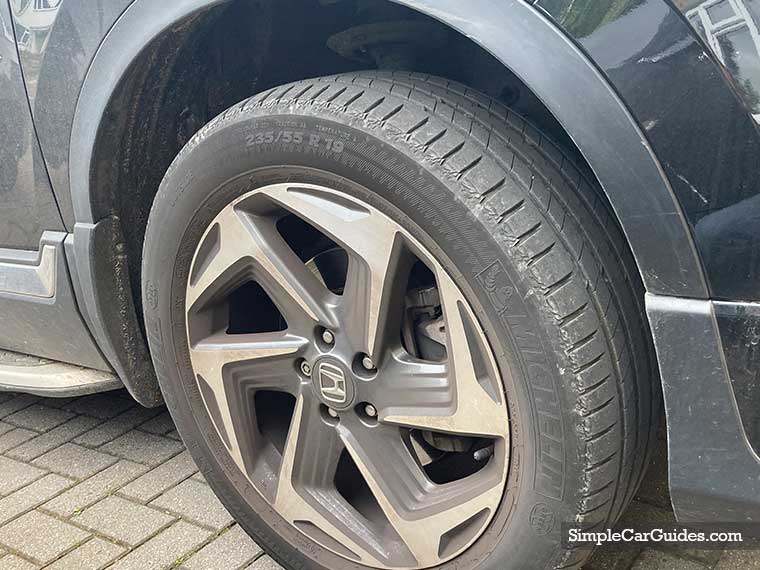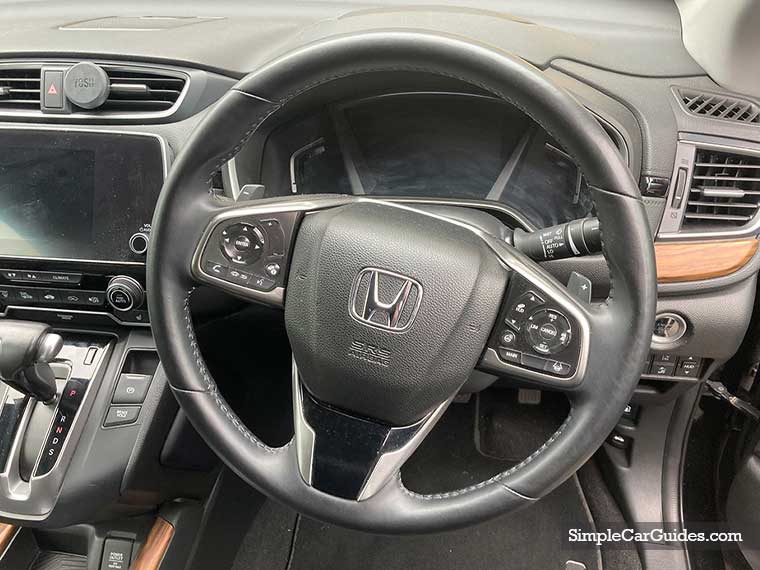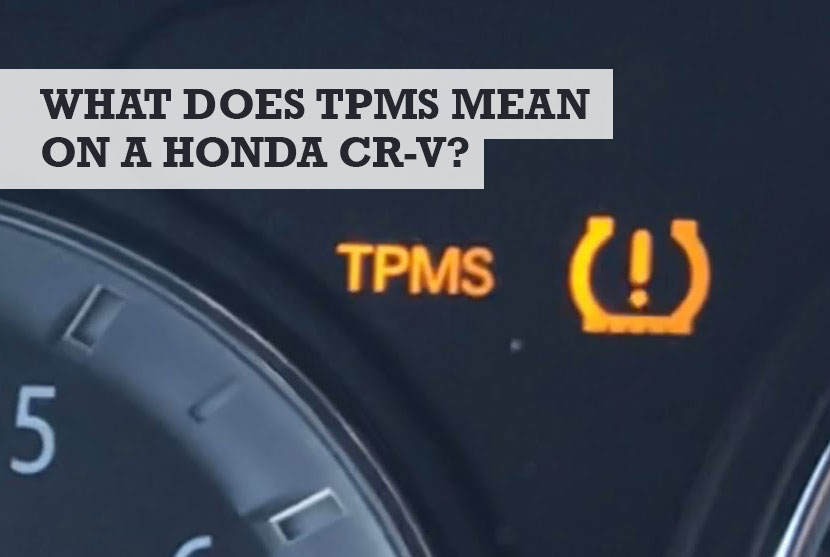The sudden appearance of the TPMS light appearing on the dash of your Honda CR-V can be quite anxiety inducing, particularly if you don’t know what it means. And in truth, you should be concerned when you see it as it points towards an issue with tire pressure.
What does TPMS mean on a Honda CR-V? TPMS on a Honda CR-V means “Tire Pressure Monitoring System”. It’s a safety feature designed to tell the driver via a TPMS light when the CR-V’s tires are losing pressure. Honda CR-V TPMS can sense the smallest change in tire pressure.
So that’s the simple answer about TPMS on a Honda CR-V, but there’s more to it than that, including whether you can drive with the TPMS light on, and how to fix the warning.
Honda CR-V TPMS light meaning and causes
Whilst tire pressure is something you should check at least once a month, it’s still something that can be easily forgotten and overlooked.
Because of this reason and the fact that low tire pressure can be potentially dangerous, all vehicles sold after 2008 are mandated to have a TPMS sensor (short for Tire Pressure Monitoring System).

Why does my Honda CR-V say TPMS?
When your Honda CR-V says TPMS, it means that one or more of your tires has low pressure. The warning light is an orange tire symbol with an exclamation mark in the middle or there will be a warning light that simply says TPMS.
The Honda CR-V tire pressure monitoring systems can also be direct or indirect. All Honda CR-Vs made between 2008 and 2014 use direct sensors, but all Honda CR-Vs produced after 2014 use indirect sensors.
In the case of the indirect system, it uses a combination of different pieces of information provided by other sensors such as the ABS, so it takes a while for the system to notice a low pressure since it doesn’t have live pressure sensors in each tire like the direct Honda CR-V TPMS does.
Handy Hint: Here’s the recommend engine oil type for all years and models of the Honda CR-V.
So, if you see the CR-V TPMS warning light on your dashboard it just means that one or more of your tires is under-inflated but do keep in mind that after you have inflated the tires, the warning light won’t go out by itself, you will have to turn it off manually.
Besides this warning light being on while you are driving if, by any chance, you see it flashing for more than 30 seconds after you start the car, that means that the TPMS system is faulty and needs servicing.
After you have identified the TPMS warning light, here is how to find the correct tire pressure for your CR-V and how to cancel the warning light.
The causes of low tire pressure include natural tire deflation, weather changes, elevation changes, bad tire valve stem, and minor punctures where usually something remains stuck in the tire like a screw or a nail.
If your TPMS warning light is coming on more than once a month or every day even, it means that you either have a puncture or a bad valve and you should take your car to a tire repair shop.
Keeping your tires at the pressure recommended by the manufacturer is very important both for your tire longevity and your safety. In a Honda CR-V, you will find a tire pressure recommendation label on the driver’s side doorjamb.
This label will also include a chart with different tire pressures matching with different weights of the car determined by the number of passengers and amount of luggage, so make sure to read it carefully and decide what part of the chart applies to you.

Alternatively, you can consult your CR-V’s owner manual which will usually be more specific to your car and thus more accurate.
Once your tires are at the recommended pressure there are a couple of ways you can cancel the warning light.
For direct TPMS systems, after you have inflated the tires, you will simply accelerate to at least 28 MPH and drive the car at those speeds for at least one minute and the warning light should go out. If by any chance, this doesn’t do the trick, you can take your car to a repair shop where they will do it via the OBD2 port in your car.
Cancelling the warning lights on indirect systems is a little more complicated. This procedure will start by leaving the car in neutral or park and turning the ignition on without starting the car.
Now using the CR-V’s screen and its steering wheel controls, you should follow these steps.
- Press menu and go to Vehicle Menu.
- Select customized settings and press the Source button.
- Select TPMS calibration and press the Source button.
- Initialize.
After these steps, the screen should read that TPMS has been initialized. The screen can also read, unable to initialize TPMS and, in that case, repeat the steps one more time.
The whole process will be complete after all this is done and you have been driving between 40 and 60 MPH for at least 20 minutes.
Besides the tires possibly being under-inflated, they can also be overinflated. Both cases carry their own specific risks and possible damages. Under-inflated tires can rip a hole in the sidewall which, in the worst-case scenario, could cause the car to lose control and lead to a serious accident, or, in the best-case scenario, you will come to a controlled stop but will have to get a new tire.
Driving on an under-inflated tire over a longer period can also cause excessive wear of various suspension components and brakes. Further, it will cause difficulty controlling the car when turning or braking and will also increase fuel consumption.
An underinflated tire can be recognized by excessive wear on the outer edges while the middle of the tread remains noticeably less worn out.
Overinflated tires will have slightly different symptoms and risks, but they are not any less dangerous. With overinflation, it’s much easier to get a tire blowout that can lead to serious injury or even death.
The contact patch between the tire and the road is much smaller in this case, reducing grip and, once more, increasing the risk of crashing. Tire wear in this case is recognizable by increased treadwear in the middle of the tire and less on the outer edges.
Handy Hint: Here’s what the orange wrench light warning symbol means including all the codes.
Can I drive my Honda CR-V with the TPMS light on?
Yes, you can drive your Honda CR-V with the TPMS light on, but make sure to stop at the first service station and check your tire pressure. What causes the TPMS light to come on? If the light is permanently on, it means one of your tires is underinflated.
How do you fix a TPMS light on a Honda CR-V?
You can fix it by inflating your tires and after driving for some time, it will turn off by itself if it’s a pre-2014 model. If it’s a post-2014 model, check your owner’s manual to see how to turn it off manually.
But what is Honda TPMS is light on but the tires are fine? Well, check if the TPMS light is flashing for more than 30 seconds after starting the car. If that’s the case, then the TPMS sensor is faulty. If it stops flashing after a couple of seconds, then it just needs to be turned off manually.
The Honda CR-V tire pressure light keeps coming on
Make sure to check your tire pressure when the light is on. If it keeps deflating it means you have a puncture or a bad tire valve. If the tires aren’t deflating it means the TPMS sensor is faulty.
What does the “check fuel cap” message mean?
The check fuel cap warning message means there is a problem with your gas cap or the sensor that monitors it.
While this may seem like a minor issue, it could mean it’s loose, fuel is leaking, or an problem with the gas cap sensor’s electronics.
Conclusion
With vehicles becoming getting more advanced every year, they, in turn, have more and more sensors and electronics and, with them, more and more warning lights.
Now with all these different lights and warning symbols, it can get confusing and scary very quickly.
Luckily, the Honda CR-V TPMS sensor and its warning light are very simple and are usually nothing to worry about providing your check your tires as soon as it comes on.






